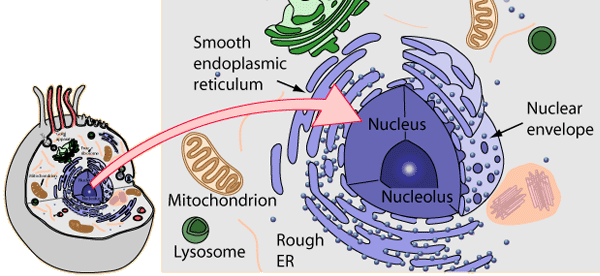Cell Nucleus and Nuclear Envelope

The nucleus of a eukaryotic cell contains the DNA, the genetic material of the cell. The DNA contains the information necessary for constructing the cell and directing the multitude of synthesis tasks performed by the cell in the process of life and reproduction.
The nuclear envelope surrounds the nucleus with a double membrane with multiple pores. The pores regulate the passage of macromolecules like proteins and RNA, but permit free passage of water, ions, ATP and other small molecules. In this way the membrane exerts some control over the information flow in the cell since information is carried by the macromolecules.
Inside the nuclear envelope is the chromatin, meaning "colored substance" after the early experiments in which that material was highly colored by the staining techniques used. Chromatin consists of DNA associated with proteins which forms long strands called chromosomes. While the DNA remains in the nucleus, it controls most of the processes that occur in the cytoplasm of the cell. Information from the DNA can be transcribed to mRNA and transmitted to other cellular synthesis processes, and information from the cytoplasm can provide feedback to the nucleus.
The nucleolus is the central portion of the cell nucleus and is composed of ribosomal RNA, proteins and DNA. It also contains ribosomes in various stages of synthesis. The nucleolus accomplishes the manufacture of the ribosomes.
Reference
Hickman, et al.
Ch 4
Audesirk & Audesirk
Ch 6
| HyperPhysics***** Biology | R Nave |